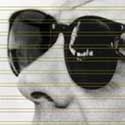
Who The Hell’s In It
by Peter Bogdanovich
Knopf
[[Bogdanovich Cover]] Peter Bogdanovich eerily predicted his place in Hollywood history when he worried, in 1971: “I hope I’m not repeating what happened to Orson. You know, make a successful serious film like [The Last Picture Show] early and then spend the rest of my life in decline.”
Unfortunately, that’s pretty much what happened. But before he was a major and then a minor filmmaker, Bogdanovich was a star-struck journalist, having broken into that field in the 1960’s. He’s continued writing as a secondary career, having produced almost half as many books as he has films.
Who The Hell’s In It, a study of actors in film, is a successor in interest (and title) to Bogdanovich’s previous look at directors, Who The Devil Made It. The length of the profiles collected in the book is based almost entirely upon the amount of time Bogdanovich has spent with the actors being discussed. As a result, the book is strangely lumpy.
Why does Jerry Lewis rate 75 pages while Humphrey Bogart gets only 21? Because Bogdanovich never met Bogart, but Lewis is a friend. Whether despite this or because of it, the Bogart piece is one of the best in the book–in fact the best piece on Bogart I have ever read. And it’s not to say that there is nothing of value in the Lewis section; Bogdanovich writes tellingly of Lewis near the height of his solo success, when they first met. But it’s indicative of the uneven feel of the book that he also writes too indulgently of the clown in the autumn of his years. And–meaning Lewis no slight–would he bestride anyone else’s book like a colossus (to steal a phrase Bogdanovich uses about Jimmy Stewart–10 pages–elsewhere) as large as Bogie? Let alone so much larger?
This sort of maddening discrepancy also surfaces in Bogdanovich’s profiles of Marilyn Monroe and Audrey Hepburn. Monroe, whom he never met formally but shared an acting class with once, is sketched in a portrait that is commendably sensitive. Albeit one that relies more heavily upon a candid interview with Arthur Miller than Bogdanovich’s own observations. But for Hepburn, with whom he actually made a film, Bogdanovich practically writes a florid hymn:
“…she gave so much of the best of herself to everyone and to everything she did…in her life and work she was born to show the world that true grace and innocence, human kindness and hope, can still exist on earth.”
Whew! This tendency towards myopia mixed with surprisingly amateurish bombast and “very special” tribute becomes comical by the time you reach Bogdanovich’s memories of Anthony Perkins. When he alludes to “rumors that Tony was gay,” it’s difficult for anyone who has read Charles Winecoff’s compassionate, insightful Split Image: The Life of Anthony Perkins to suppress a snort. And at the end of the otherwise heartfelt Frank Sinatra chapter, Bogdanovich can think of no more “accurate summation of what [Sinatra] has meant to six decades of lovers” than to quote Barry Manilow.
In a full-fledged memoir, which Bogdanovich has certainly lived a controversial and compelling enough life to write, this favoritism would be less troublesome, if not the weakness for insipid prose. A man is entitled if not expected to emphasize the parts of his life story that mean the most to him. But if that man intends to write a serious study of craftsmen, it’s eventually distracting when he can’t even write about Charlie Chaplin without making it the story of how he, Peter Bogdanovich, saved the Academy Awards tribute to The Little Tramp.
There are also a disappointing number of mistakes in the book. Some of these are surely nitpicking, but some betray Bogdanovich’s credulousness in the presence of stars. He quotes Orson Welles telling an anecdote about Dean Martin; the story is funny, yes…but it was even funnier when Pat Buttram told it about George Gobel.
And was there ever a proclamation so simultaneously dense yet as thinly veiled as this?
“Preconceived notions of what celebrated people are like must account for a good measure of all the misunderstanding and hostility in our ever more informed society.”
Ooh, must they.
Still, it’s easy to see why Bogdanovich was able to make a living as a writer; when all cylinders are firing, he has an ear for characteristic quotes that bring his subjects to warm-blooded life. Who The Hell’s In It is a more satisfactory read for more casual movie buffs than Who The Devil Made It. That book is a bit impenetrable except for film historians and collectors. But I do wonder whether a third volume on writers in film is in the works.
Called perhaps, given the studios legendarily cavalier attitude towards changing scripts, Who Wrote This Piece Of Offal?












